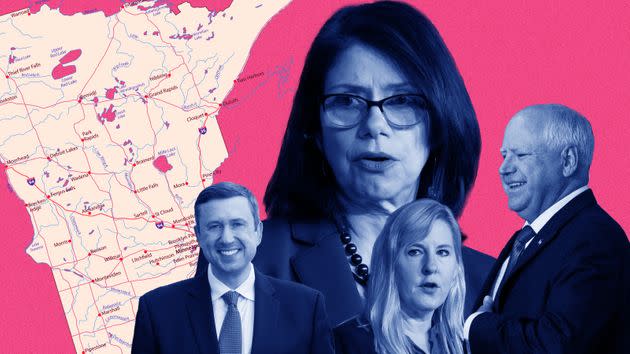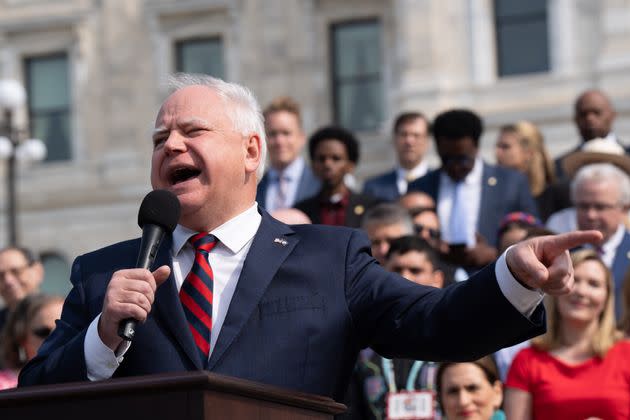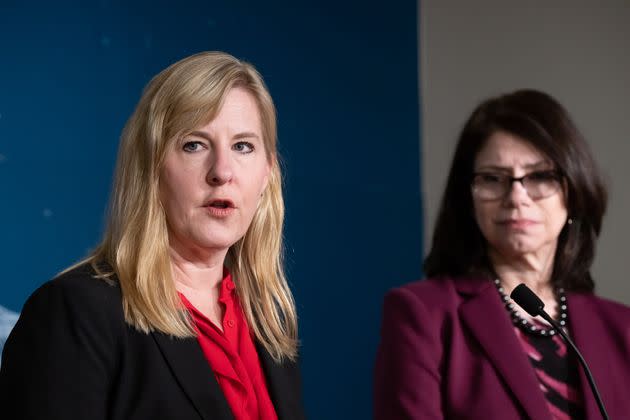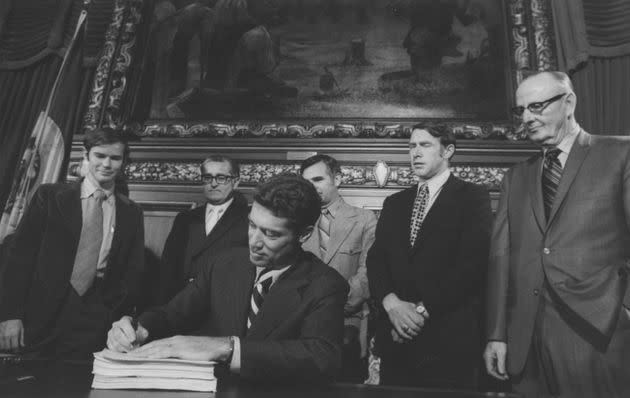How Minnesota Democrats Passed A Raft Of Progressive Legislation With A 1-Seat Majority

A composite image showing, from left, Minnesota Democratic-Farmer-Labor Party Chair Ken Martin; state Senate Majority Leader Kari Dziedzic; state House Speaker Melissa Hortman; and Gov. Tim Walz.
President Joe Biden spent his first two years in office with unified control of the federal government, only to see Democrats’ bare-bones majorities in the U.S. House and Senate significantly limit his legislative agenda on everything from climate to gun control to protecting abortion rights.
Minnesota Democrats entered this year’s legislative session in a similar situation. Last fall, they won control of the state’s executive branch, House and Senate — a legislative “trifecta” — but with only a one-seat majority in the upper chamber. The results were much different: The party accomplished a generation’s worth of liberal reforms in just four months, vaulting the state to the forefront of progressive policymaking.
Minnesota now offers 12 weeks of paid family and medical leave, the opportunity for any resident to buy into Medicaid, free public college tuition for low- and middle-income families, a new child tax credit for those families, free breakfast and lunch for all public school students, driver’s licenses for all residents regardless of their immigration status, and stronger protections for workers seeking to unionize.
Take a deep breath — there’s more coming.
Middle-class seniors will no longer have to pay state income taxes on Social Security benefits. A law immediately restoring the voting rights of felons who have completed their prison sentences expanded the franchise to 55,000 more people. Minnesotans serving life behind bars for crimes they committed as minors are now eligible for supervised release 15 years into their sentence. Suspending gun permits for people experiencing a mental health crisis got easier. Recreational marijuana is legal. A new state law protects abortion rights. A “trans refuge” law shields transgender children who travel to Minnesota for medical transitions from legal repercussions in their home states. And Minnesota has set a goal of moving to 100% carbon-free energy by 2040.
The no-holds-barred progressive lawmaking spree was even enough to get a Twitter shoutout from former President Barack Obama, who called it a “reminder that elections have consequences.”
Leaders of Minnesota’s Democratic-Farmer-Labor Party, as the state’s Democratic Party is known, have taken to calling the flurry of legislative activity the “Minnesota Miracle 2.0.” Originally, “Minnesota Miracle” was a nickname given to reforms enacted in the early 1970s by then-Gov. Wendell “Wendy” Anderson (DFL) and liberal Republicans in the Legislature, which increased funding for public schools by raising state income taxes and reducing the education system’s reliance on regressive property taxes.
We’re an island of decency up here.Minnesota Gov. Tim Walz
That first Minnesota Miracle stemmed from “the belief that getting a healthy, well-educated population with a safety net when people fall on tough times is not only morally the right thing to do, it’s economically the right thing to do,” Minnesota Gov. Tim Walz (DFL) told HuffPost. “We’re doubling down on that.”
He added, “We’re an island of decency up here,” referring to more conservative neighboring states like North Dakota.
There are a number of factors that enabled the DFL to press its advantage in such short order. Regrets over the caution exercised during the previous period of a Democratic legislative trifecta in Minnesota, and anxiety over the rightward shift of Republican-led states, fueled a sense of urgency.
The DFL is more ideologically uniform than it once was. A $17.5 billion budget surplus gave the party room to run. Walz, House Speaker Melissa Hortman and Senate Majority Leader Kari Dziedzic kept their legislators in line. And the campaign infrastructure that carried the DFL to power, and is working hard to keep them there, is among the country’s most sophisticated.
“To not lose a single state senator on all of these major pieces of Democratic legislation — that’s either an incredible job done by Walz and the party leaders in the Legislature keeping everybody in check or getting things in the bill that they needed, or this is a lot of people who think alike and there’s not a lot of dissenting voices in the caucus to begin with,” said Eric Ostermeier, a research fellow at the University of Minnesota’s Center for the Study of Politics and Governance, where he runs a nonpartisan data and analysis site called Smart Politics. “I suspect it’s a little bit of both.”
Meanwhile, state Republicans are hoping to make Democrats pay at the polls in 2024, when they have the chance to retake the state House.
Walz has effectively welcomed whatever political consequences will come, writing on Twitter, “You don’t win elections to bank political capital – you win elections to burn political capital and improve lives.”
But Walz will retain his veto power until at least 2026, when his second term expires; barring any unforeseen events, the state Senate is set to remain in Democratic hands until then as well. It’s also unclear whether Republicans want to be on record trying to overturn popular aspects of the Democratic agenda.
“There are certainly things they did that people will really like,” acknowledged former state Senate GOP leader Amy Koch, citing the free school meals and investment in early childhood education.

Walz speaks in late May before signing a new budget bill.
From Disarray To Dominance
The Democratic-Farmer-Labor Party’s present moment of triumph began in 2010, which was a relative low point for the party. Mark Dayton, a liberal and department store heir, had won the governorship by a hair, sparing the DFL the wipeout fate of Democrats in many other states.
But the party had lost control of both state legislative chambers and a U.S. House seat it had held for decades in northeastern Minnesota’s Iron Range region. Dayton asked his campaign manager, Ken Martin, to run for chair of the state party. A conversation with Alida Rockefeller Messinger, Dayton’s ex-wife and a major liberal philanthropist, helped seal the deal.
“Democrats were demoralized,” Martin recalled. “The state party was broke and near bankruptcy.”
Martin, a veteran Democratic operative, is now in his seventh two-year term heading the DFL, making him the longest-serving DFL chair in state history. He is widely credited with building the infrastructure that propelled Minnesota Democrats to their current level of dominance. The most recent time that a Republican won a statewide office in Minnesota was in 2006, when then-Gov. Tim Pawlenty secured a second term. Minnesota trails only California, Connecticut and New York in terms of consecutive elections for statewide offices in which Democrats have swept all contested seats, according to numbers crunched by Ostermeier.
The keys to Martin’s success? Long before the 2016 and 2018 elections sped up the state’s partisan demographic realignment, Martin saw that the battle for future control of the state would take place in the Twin Cities’ mostly middle-class and affluent suburbs. He made sure to invest in grassroots organizing and candidate recruitment in onetime Republican strongholds like Plymouth and Stillwater.
“As Wayne Gretzky, the great hockey player, once said, ‘You have to skate to where the puck will be, not where the puck is,’” Martin said, referencing a sport that is very popular in Minnesota.
None of that would have been possible if Martin wasn’t a prodigious fundraiser, bringing in $37 million for the party to spend on state and federal races in the 2022 midterm cycle alone. Martin marshals that money to provide services for individual candidates that they might not otherwise be able to afford, including opposition research and field organizing. (The latter is less important for the DFL’s Senate and House caucuses, which run their own ambitious field programs.)
Martin’s “oppo” handiwork, and a robust DFL press operation that knows how to make it stick, were apparent in pivotal contests in 2022. In a race for an open seat in rural Moorhead that Democrats held onto, the DFL unearthed court documents from Republican Dan Bohmer’s divorce in which his former wife testified that Bohmer had called her vile things, including a slur against women.
The role of the state party is to take the low road, so our candidates can take the high road.Ken Martin, chair of the Democratic-Farmer-Labor Party
In Attorney General Keith Ellison’s contentious race for reelection, the DFL found the paper trail of Republican challenger Jim Schultz’s history of activism in the anti-abortion movement. The party also filed a complaint against Schultz’s campaign for allegedly violating campaign finance laws, prompting an official investigation that ultimately cleared Schultz of the main charges months after he lost his election.
“The role of the state party is to take the low road, so our candidates can take the high road,” Martin said.
Republicans have a grudging admiration of Martin’s work. “I’ve said, ‘Ken, can you get a real freakin’ job so you can give us a real chance?’” GOP strategist Patrick Connolly told HuffPost.
Koch had a similarly bittersweet appraisal. “He does keep a steady hand at the rudder, damn it!” she said. “I hope we can find someone like that.”
State parties have long been an afterthought for many Democrats — not least in blue states, where they sometimes become extensions of a governor’s patronage operation.
But the centrality of Martin’s party operation has become a model for neighboring states like Wisconsin, where Democrats hope to replicate his success. Democratic Party of Wisconsin Chair Ben Wikler, who led his party to victory in a critical state Supreme Court race in April, told HuffPost that he and his staff met with Martin at the DFL’s headquarters shortly after taking office in 2019 to soak in as much information as possible.
Martin’s “vision has guided my work ever since,” Wikler said in a statement.
Even Martin concedes, however, that he is heir to an illustrious Minnesota tradition of progressive organizing.
Before Martin’s tenure as chair, the family of the late progressive Sen. Paul Wellstone, who died in a tragic plane crash in 2002, created Camp Wellstone, an organizing bootcamp for DFL candidates, activists and operatives. Walz credits the program, which is now run entirely by the DFL, for preparing him for his successful 2006 U.S. congressional run at a time when he was a high school teacher and football coach without any political experience. His instructor at Camp Wellstone was then-school board member Peggy Flanagan, who is now his lieutenant governor.
“The credit is to a long progressive history and an infrastructure that understands that … it’s not just about good ideas, it’s about organization and execution,” he said.

Hortman and Dziedzic are pictured at press conference laying out the priorities of the DFL majority on Jan. 4 in St. Paul, Minnesota.
Holding The Line
When Walz, Hortman and Dziedzic convened after the November 2022 election, they were in complete agreement that they would move swiftly to pass as much transformative legislation as possible.
Both Hortman and Dziedzic had been in the Legislature during the previous Democratic trifecta in 2013 to 2014. Dayton, then the governor, and the DFL majorities made a number of progressive strides, including legalizing same-sex marriage, using Affordable Care Act funds to expand Medicaid, guaranteeing a free full day of kindergarten, and raising taxes on higher earners to fund their priorities.
But Dayton and his colleagues held back for fear of alienating the electorate ahead of the 2014 elections, Hortman recalled. Priorities like a minimum wage increase got watered down or left by the wayside. Progressives were disappointed. Four decades after a 1973 Time magazine cover featuring Anderson, the governor, dubbed Minnesota “A State That Works,” a liberal specialist in Minnesota’s suite of 1970s reforms lamented that the moniker might “not fit Minnesota as comfortably as it once did.”
Despite the DFL’s caution, the party lost its majority in the state House in 2014, amid one of the worst midterms in the centurieslong history of the Democratic Party. Many analysts characterized the outcome as another midterm backlash to Obama, made worse by the then-president’s disinterest in investing in national Democratic Party infrastructure.
“We lost our trifecta, but it wasn’t at all because of what we did during the trifecta,” Hortman said.
To Hortman, and her colleagues, the lesson was clear: “We will worry about the next election when the next election comes around.” In the meantime, they planned to make up for time lost during periods of divided government with what Hortman called the “#LFG session” — an acronym for “let’s fucking go.”
The state’s flush coffers, bolstered by Biden’s COVID-19 relief bill and partisan gridlock that prevented more spending in the previous session, gave the DFL more leeway to fund its priorities.
But keeping caucus discipline in the House, where the DFL has a six-seat majority, left little room for error.
And the math in the state Senate, where the DFL could not afford to lose a single Democrat on party-line votes, was downright perilous.
Dziedzic did her best to accommodate the concerns of members in swing seats, especially those of the four “majority-makers.” That group includes state Sen. Heather Gustafson, the sole Democrat to flip a Republican-held seat, as well as state Sens. Rob Kupec, Grant Hauschild and Judy Seeberger, who won in Democratic-held open seats outside of the Twin Cities metropolitan area that had been shifting to the right.
Numerous intraparty compromises emerged from discussions within the DFL Senate caucus. A public safety bill included additional money to hire police officers in rural communities that want it, but also had funding for mental health emergency services and treatment not tied to the police. In an effort to appease Hauschild and other rural lawmakers, language in the legislation closing loopholes in the state’s background check system for gun purchases clarified that the state would not be assembling a centralized registry of gun ownership.
And to satisfy concerns raised by Gustafson, a suburban school teacher who unseated a Republican with an affinity for a racist and misogynistic right-wing manifesto, the bill legalizing cannabis made it easier for towns to contact local law enforcement about marijuana dispensaries that violate the law.
We worked really hard to make sure everybody got heard.State Sen. Heather Gustafson
“We worked really hard to make sure everybody got heard,” recalled Gustafson, who praised Dziedzic’s skills as a consensus builder.
Passing the state’s new paid family and medical leave program was the most difficult lift. The program provides up to 12 weeks of partial wage replacement for a single medical or family event, and a combined maximum of 20 weeks per year.
The Minnesota Chamber of Commerce came out squarely against the law, objecting to a 0.7% tax to fund the program that would be split between employers and employees.
Dziedzic and her colleagues ended up adding clauses designed to lighten the burden of small businesses, including by reducing the amount that businesses with fewer than 30 workers have to pay into the program.
Grassroots progressive groups, like the interfaith coalition Isaiah, also played a critical role in demonstrating to swing-seat senators that significant local constituencies supported the bill.
State senators faced a “lot of real-world pressure” to oppose the paid family and medical leave bill, said Doran Schrantz, the executive director of Isaiah, whose political arm is called Faith in Minnesota. “If there was not a counter-pressure that was equally strong, those become very hard votes for those senators.”
The legislative session became that much more challenging when Dziedzic announced in March that she had cervical cancer. She missed weeks of in-person working to undergo surgery and other treatment, but ignored her doctors’ insistence that she take more time off. She participated in a number of critical video calls with Walz and Hortman while receiving chemotherapy.
Dziedzic credits the experience with adding to her perspective. She said that a receptionist who was next to her in the hospital needed a doctor’s note to return to her job and had suffered financially from the lost work time.
“It did solidify for me why we need paid family and medical leave,” she said.
Of course, the DFL’s expansion in the suburbs and contraction in socially conservative rural areas has made it a more ideologically homogeneous party than in the past. There is no equivalent, for example, of U.S. Sen. Joe Manchin (D-W.Va.) in the Minnesota state Senate’s DFL caucus.
And the same partisan polarization that has limited the Minnesota GOP’s ability to appeal to moderate voters has increased the likelihood that any DFL state senator who bucks their party on a key priority will face a primary challenge. The stakes of party approval in Minnesota are also higher than in many other states, because both the DFL and the Minnesota Republican Party bestow official endorsements on candidates before primary elections, even when those contests are competitive.
For those reasons, Ostermeier said, “Voting against some of these policies isn’t necessarily going to ensure” Democrats’ reelection in swing seats.

Then-Minnesota Gov. Wendell "Wendy" Anderson (DFL), seated, signs a tax and education funding reform bill in 1971. The contemporary DFL is more racially diverse.
Whither The GOP In A Multiracial Social Democracy?
Tom Berg, who was a DFL state representative in the 1970s and authored a 2012 book about the period called “Minnesota’s Miracle,” has registered an objection to the term “Minnesota Miracle 2.0” on technical grounds. The 1971 education funding reform was, he notes, “miraculous,” in part because it was the product of bipartisan collaboration between Anderson and a state Legislature controlled by Republicans (though prior to 1973, Minnesota legislative factions were nonpartisan and known as “liberal” or “conservative”). The DFL’s subsequent takeover of the state Legislature in the 1972 elections resulted in a generational shift and a more comprehensively liberal set of policy changes.
Berg also points out that while he and his colleagues addressed a narrow component of fiscal policy in 1971, “this session, the [DFL] did an awful lot on all fronts,” he said approvingly. “It is a truly major deal.”
Other progressives highlight another element of the “Minnesota Miracle 2.0” that is an improvement on its namesake: Although the DFL began diversifying in the 1970s, the coalition that assembled the current reforms contains far more women and nonwhite people than the state’s old liberal guard ever did.
Women now make up a majority of the DFL’s state Senate caucus. And the DFL counts 10 nonwhite senators among its 34 members, including the first three Black women senators in state history.
“A lot of the backlash politics [in Minnesota] are about race,” Schrantz said. “The fact that we could get to a place in 2023 where racial justice and equity were part of the lens of governing is a significant pivot point. So it was maybe a real miracle, as opposed to the one that happened in the ’70s.”
Minnesota Republicans have grown more diverse as well. For example, state House GOP leader Lisa Demuth is Black, making her the first Black leader of any of the state’s legislative caucuses.
It was maybe a real miracle, as opposed to the one that happened in the '70s.Doran Schrantz, executive director of Isaiah
Other aspects of the party’s makeup in the Legislature are less representative of the state’s diversity. Of the Minnesota Senate’s 33 Republicans, only three are women.
The demographic reality in the state Capitol corresponds to a political reality among Minnesota women. In 2022, public anger over the U.S. Supreme Court decision undoing a federal right to abortion played a major role in propelling women in the state toward Democrats, helping the party overcome polling that failed to predict the DFL’s takeover of the Legislature.
There has been a “complete lack of discussion and an agenda that focuses on women” among Minnesota Republicans, Koch said.
In addition, the state’s Republican Party has struggled to emerge from the shadow of former President Donald Trump, who lost the state by a surprisingly narrow margin in 2016 but accelerated the exodus of suburban voters from the state GOP.
Scott Jensen’s victory in the Republican gubernatorial primary in 2022 spoke to Trump’s influence over the GOP base. Jensen, an anti-abortion physician who questioned the efficacy of COVID-19 vaccines and would not rule out the baseless idea that the 2020 election was stolen from Trump, lost to Walz by nearly eight percentage points in November, contributing to what many Republicans believe was the party’s poor down-ballot performance.
In an interview with HuffPost, Demuth declined to comment on Trump, Jensen, or the question of whether the hard right is hurting Republicans at the ballot box. She also refused to commit to votes repealing key parts of the Democrats’ agenda this session.
Instead, Demuth claimed credit for ensuring that the largely DFL-drafted state budget included significant new funding for nursing homes, and for a losing effort to means-test free school meals that Republicans believe would have made the program more financially sustainable. She also vowed to fight for the full exemption of Social Security benefits from state income taxes, and the reduction or elimination of several tax increases from Democrats, including the payroll tax to fund paid family and medical leave.
Most of all, Demuth plans to pitch moderate Democrats and independents on the opportunity to restore “balance” and place a check on Walz’s taxation and spending agenda.
“That voice of almost 48% of Minnesotans, because our margins are so slim — it would bring their voice back into play and be able to stop some of the most concerning things, and bring balance back to state government in Minnesota,” she said. “That’s something that is sorely lacking.”
